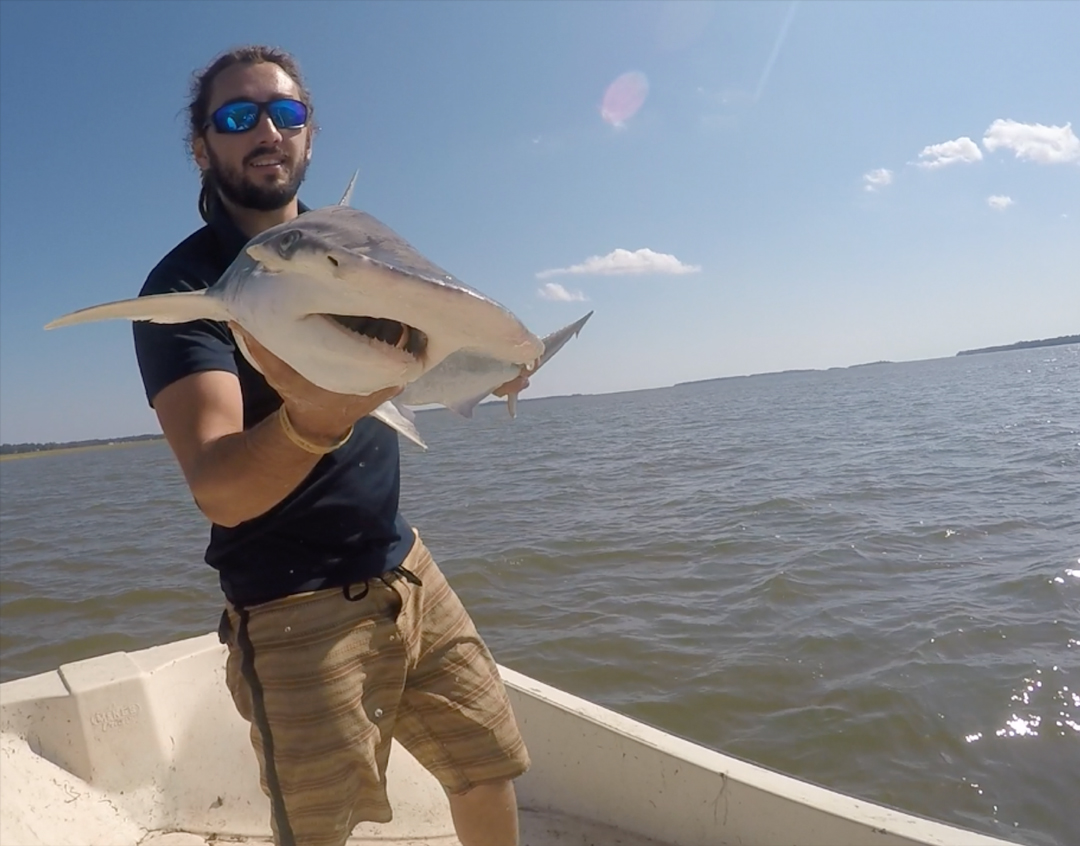
GPS For Sharks
Finding your way home every year is complicated enough when you have GPS shouting instructions at you as you drive, but how do sharks who don’t have access to Google Maps cope? After all, it’s not like they can ask Siri for directions. Cue researchers from Save Our Seas Foundation and Florida State University Coastal and Marine Laboratory who have been investigating that very issue.
Bryan Keller and Ashley Dawdy prepped for tracking and awaiting departure. Photo credit © Cheston Peterson from Save Our Seas blog.
While we know that some sharks travel over long distances to reach specific locations year after year, scientists had long speculated that sharks were using magnetic fields to navigate. However, the major challenge for them was to figure out a way to test this in sharks.
“It had been unresolved how sharks managed to successfully navigate during migration to targeted locations. This research supports the theory that they use the Earth’s magnetic field to help them find their way; it’s nature’s GPS.” Bryan Keller, Save Our Seas Foundation project leader stated when talking about the research.
Keller and his team used magnetic displacement experiments to test 20 juvenile, wild-caught bonnethead sharks. They exposed sharks to magnetic conditions representing locations hundreds of kilometres away from where the sharks were actually caught. This allowed the team to make predictions about how the sharks would position themselves if they relied on magnetic currents.
If these sharks derived positional information from the geomagnetic field, Keller predicted that the sharks would head in a northward orientation in the southern magnetic field and southward orientation in the northern magnetic field, as the sharks attempted to navigate their way testing environment. And, it turned out, the sharks acted as the team predicted when exposed to areas within their natural range.
“To be honest, I am surprised it worked,” Keller said. “The reason this question has been withstanding for 50 years is because sharks are difficult to study.”
Keller and his team suggest that this ability to navigate based on magnetic fields may also contribute to the population structure of sharks. The findings in bonnetheads also likely help to explain impressive features by other shark species. For example, a great white shark was recorded to migrate between South Africa and Australia, returning to the exact location the following year.
“How cool is it that a shark can swim 20,000 kilometers round trip in a three-dimensional ocean and get back to the same site?” Keller said “It really is mind blowing. In a world where people use GPS to navigate almost everywhere, this ability is truly remarkable.”
We were fortunate enough to catch up with Bryan, who answered some quick questions about his research for us.
So Bryan, how did you become interested in this area of research?
Migrations have always fascinated me. How cool is it that a shark can swim 20,000 km roundtrip in a three-dimensional ocean and get back to the same beach? Seriously?! It really is mind-blowing. In a world where people use GPS to navigate almost everywhere, this ability is truly remarkable. I had wanted to study this topic for my dissertation since 2014 and the idea has been in the works since then. I began by reaching out to my advisor, Dr Dean Grubbs, and from there we put together the rest of the team to make the paper a success!
What is the Save Our Seas Foundation all about?
The Save Our Seas Foundation has funded both my M.Sc. and Ph.D. research. The organization is truly responsible for advancing the conservation and management of elasmobranchs on a global scale. Here is a snippet from their website: Since 2003, the Save Our Seas Foundation has been dedicated to protecting life in our oceans, especially sharks and rays. We support passionate and innovative researchers, conservationists and educators around the globe by funding their projects and helping them to tell important scientific and environmental stories. Our centres in South Africa, Seychelles and the USA are dedicated to learning about sharks and rays and sharing that knowledge.
We read that you’re interested in further studying the effects of magnetic fields from submarine cables on sharks. How would this further research tie into your current research on sharks using magnetic fields to find their “home”?
If sharks use the magnetic field to aid them in navigation, then any anomalies in the magnetic field could potentially interfere with their movements. Whether these anomalies would interfere with navigation is unknown and more research needs to be done.
Besides sharks, is there any other topic of research that you would be interested in?
Animals of all sorts fascinate me. I have also conducted research on teleost fishes, but maybe one day I will be able to work with other taxa – I am especially interested in predatory birds, large cats and wolves.
Where can our listeners (and readers) follow you to keep up to date with your research?
Follow me on Instagram @bryankeller!
Want to know more? Check out this is video:
Want to read the full research? Here’s the citation:
Bryan A. Keller, Nathan F. Putman, R. Dean Grubbs, David S. Portnoy, Timothy P. Murphy. Map-like use of Earth’s magnetic field in sharks. Current Biology, 2021; DOI: 10.1016/j.cub.2021.03.103


